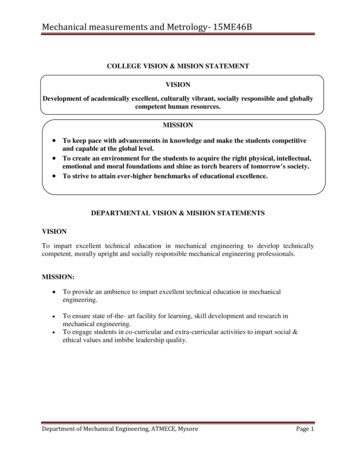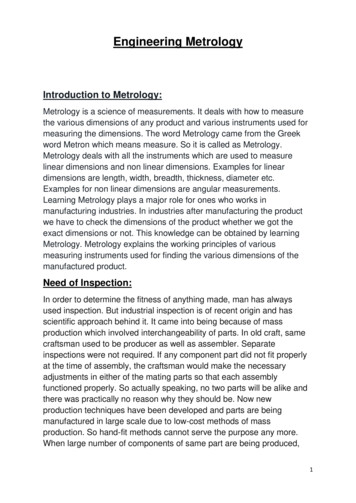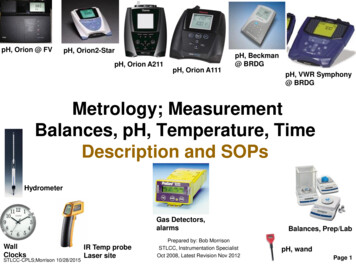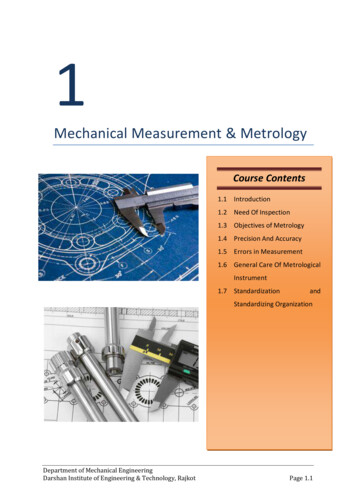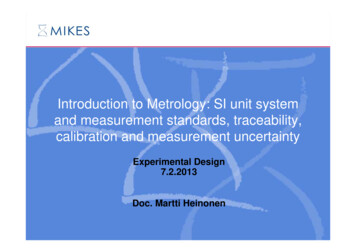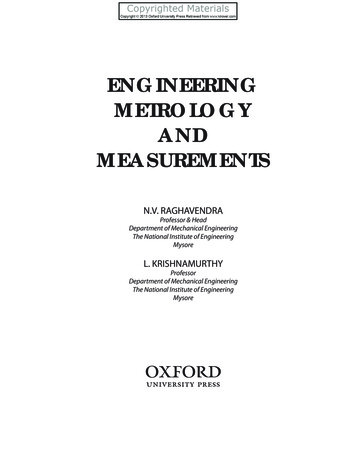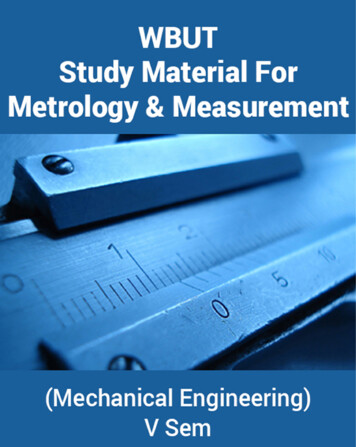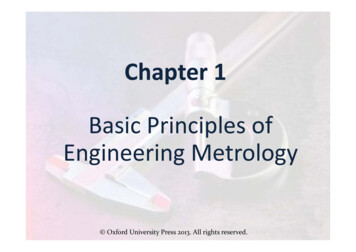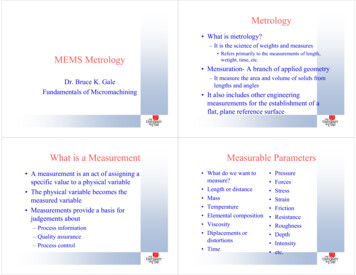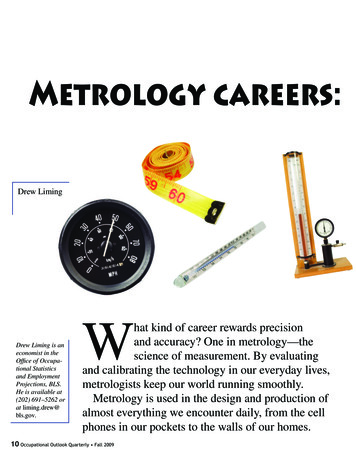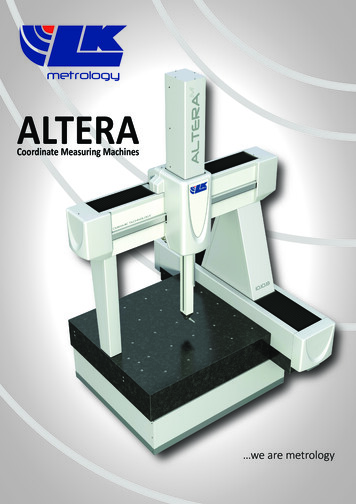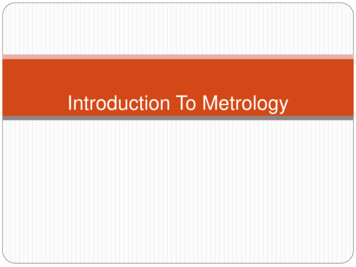
Transcription
Introduction To Metrology
Meaning of Metrology Metrology is the science of measurement. Metrology may be divided dependingupon thequantity to be measured like metrology of length,metrology of time. But for engineering purposes, it is restricted tomeasurement of length and angles and other qualitieswhich are expressed in linear or angular terms. In the broader sense it is not limited to lengthmeasurement but is also concerned with industrialinspection and its various techniques.
Continue. Metrology is mainly concerned with:(1) Establishing the units of measurements, ensuringthe uniformity of measurements.(2) Developing methods of measurement.(3) Errors of measurement.(4) Accuracy of measuring instruments and their care.(5) Industrial inspection and its various techniques.
Legal Metrology Legal MetrologyLegal metrology is directed by a national organizationwhich is called national service of Legal metrology. Itincludes a no. of international organization whoseultimate object is to maintain uniformity ofmeasurement throughout the world. The activities of legal metrology are:(1) Control of measuring instruments.(2) Testing of prototype/models of measuringinstruments.(3) Examination of measuring instrument to verify itsconformity.
Necessity and importance of Metrology In design, design engineer should not only check his design from the point of view of the strengthor economical production, but he should alsokeep in mind how the dimensions specified canbe checked or measured.Higher productivity and accuracy can beachieved by properly understood, introduced theMetrology.You can improve the measuring accuracy anddimensional and geometrical accuracies of theproduct.
Continue. Proper gauges should be designed and usedfor rapid and effective inspection.Also automation and automatic control, whicharethemoderntrendsforfuturedevelopments, are based on measurement.Digital instruments also we can used forinspection.
Quality control – Metrology as ameansto achieve Whenever parts must be inspected in largenumbers hundred percent inspection of eachpart is not only slow and costly but in additiondoes not eliminate all of the defective pieces. Mass inspection tends to be careless,operators become fatigue and inspectiongauge become worn or out of adjustmentmore frequently. Quality control enables an inspector to samplethe part being produced in a mathematicalmanner and to determine whether or not theentire stream of production is acceptable.
Continue. 1)2)3)4)5)The following steps must be taken while usingquality control techniques.Sample the stream of product.Measure the desired dimension.Calculate the deviations of the dimensions from themean dimension.Construct a control chart.Plot succeeding data on the control chart.
Objectives of Metrology: 1.2.3.4.The basic objective of a measurement is toprovide the required accuracy at a minimumcost.Complete evaluation of newly developedproducts.Determination of Process Capabilities.Determination of the measuring instrumentcapabilities and ensure that they are mising the cost of inspection byeffective and efficient use of availablefacilities.
Continue.5. Reducing the cost of rejects and reworkthrough application of statistical qualitycontrol techniques.6. To standardise the measuring methods.7. Tomaintaintheaccuraciesofmeasurement.8. To prepare design for all gauges andspecial inspection fixtures.
Process of measurement: The sequence of operations necessary for theexecution of measurement is called process ofmeasurement. There are main three important elements ofmeasurement,(1) Measurand:- Measurand is the physical quantity orproperty like length, angle, diameter, thicknessetc. to be measured.
Continue.(2) Reference:- It is the physical quantity or property to whichquantitative comparisons are made.(3) Comparator:- It is the means of comparing measuringmeasurand with some reference. Suppose a fitter has to measure the length ofM.S. plate- he first lays his rule along the flat. Hethen carefully aligns the zero end of his rule withone end of M.S. flat and finally compares thelength of M.S. flat with the graduations on hisrule by his eyes. In this example, the length ofM.S. flat is a measurand, steel rule is thereference and eye can be considered as acomparator.
Methods of Measurement: The methods of measurement can be classified as:(1) Direct method: This is a simple method of measurement, in which the value ofthe quantity to be measured is obtained directly without thecalculations. For example, measurements by scales, vernier callipers,micrometers, bevel protector etc. This method is most widely used in production. This method isnot very accurate because it depends on human judgment.(2) Indirect method: In indirect method the value of quantity to be measured isobtained by measuring other quantities which are functionallyrelated to required value. for example, angle measurement by sine bar, measurement ofshaft power by dynamometer etc.
Measuring system: A measuring system is made of five elements:--These are:(1) Standard(2) Work piece(3) Instrument(4) Person(5) EnvironmentThe most basic element of measurement is a standard withoutwhich no measurement is possible.Once the standard is chosen select a work piece on whichmeasurement will be performed.Then select a instrument with the help of which measurementwill be done.The measurement should be performed under standardenvironment.And lastly there must be some person or mechanism to carry outthe measurement.
Accuracy: Accuracy is defined as the closeness of themeasured value with true value.OR Accuracy is defined as the degree to whichthe measured value agrees with the truevalue. Practically it is very difficult to measure thetrue value and therefore a set of observationsis made whose mean value is taken as thetrue value of the quantity measured.
Precision: A measure of how close repeated trials are to eachother. ORThe closeness of repeated measurements.Precision is the repeatability of the measuringprocess. It refers to the group of measurements forthe same characteristics taken under identicalconditions.It indicated to what extent the identically performedmeasurements agree with each other.If the instrument is not precise it will give differentresults for the same dimension when measured againand again.
Distinction between Precision andAccuracy
Figure shows the difference between the concepts ofaccuracy versus precision using a dartboard analogy thatshows four different scenarios that contrast the two terms.A: Three darts hit the target center and are very closetogether high accuracy and precisionB: Three darts hit the target center but are not very closetogether high accuracy, low precisionC: Three darts do not hit the target center but are veryclose together low accuracy, high precisionD: Three darts do not hit the target center and are notclose together low accuracy and precision
Factors affecting the accuracy ofthe measuring system: Thebasic components of an accuracyevolution are the five elements of a measuringsystem such as:1. Factors affecting the calibrationstandards.2. Factors affecting the work piece.3. Factorsaffectingtheinherentcharacteristics of the instrument.4. Factors affecting the person, who carriesout the measurements.5. Factors affecting the environment.
Continue.1. Factors affecting the standard. It may be affecting by:- Coefficient of thermal expansion,- calibration internal- stability with time- elastic properties- geometric compatibility2. Factors affecting the work piece, these are- cleanliness, surface finish, surface defects etc.- elastic properties- hidden properties- arrangement of supporting workpiece.
Continue.3 .Factors affecting the inherent characteristics ofinstrument.- Scale error- effect of friction, hysteresis, zero drift- calibration errors- repeatability and readability- constant geometry for both workpieceandstandard4. Factors affecting person:- training skill- ability to select the measuring instruments andstandard- attitude towards personal accuracy achievements- sense of precision appreciation
Continue.5. Factors affecting environment:- temperature, humidity etc.- clean surrounding and minimum vibration enhanceprecision- temperature equalization between standard, workpieceand instrument,- thermal expansion effects due to heat radiation fromlights, heating elements, sunlight and people.The above analysis of five basic metrology elements canbe composed into the acronym.SWIPE for convenient referenceWhere, S- standardW- WorkpieceI- InstrumentP- PersonE- Environment
Sensitivity: Sensitivitymay be defined as the rate ofdisplacement of the indicating device of aninstrument, with respect to the measured quantity. Sensitivity of thermometer means that it is the lengthof increase of the liquid per degree rise intemperature. More sensitive means more noticeableexpansion.
Continue In other words, sensitivity of an instrument is theratio of scale spacing to the scale division value.For example, if on a dial indicator, the scalespacing is 1 mm and the scale division value is0.01 mm then sensitivity is 100. It is also called asamplification factor or gearing ratio.
Readability: Readability refers to the ease with which thereadings of a measuring instrument can be read. Fine and widely spaced graduation lines improve thereadability. To make the micrometers more readable they areprovided with venier scale or magnifying devices.
Calibration: The calibration of any measuring instrument isnecessary to measure the quantity in terms ofstandard unit. It is carried out by making adjustments such that theread out device produces zero output for zero input.
Continue The process whereby the magnitude of the outputof a measuring instrument is related to themagnitude of the input force driving theinstrument (i.e. Adjusting a weight scale to zerowhen there is nothing on it). The accuracy of the instrument depends on thecalibration. If the output of the measuring instrument is linearand repeatable, it can be easily calibrated.
Magnification: Magnificationis the process of enlargingsomething only in appearance, not in physicalsize so that it is more readable.(The stamp appears larger with the use of a magnifyingglass.)
Repeatability: It is the ability of the measuring instrument to repeat thesame results for the measurements for the same quantity,when the measurements are carried out- by the same observer,- with the same instrument,- under the same conditions,- without any change in location,- without change in the method of measurement,- the measurements are carried out in short intervals oftime. It may be expressed in terms of dispersion of the results.
Reproducibility: Reproducibilityis the closeness of theagreementbetweentheresultsofmeasurements of the same quantity, whenindividual measurements are carried out:- by different observers,- by different methods,- using different instruments,- under different conditions, locations, timesetc. It may be expressed in terms of the dispersionof the results.
Backlash: InMechanical Engineering, backlash, isclearancebetweenmatingcomponents,sometimes described as the amount of lostmotion due to clearance or slackness whenmovement is reversed and contact is reestablished.
Hysteresis: It is the difference between the indications of ameasuring instrument when the same value ofmeasured quantity is reached by increasing ordecreasing that quantity. It is caused by friction, slack motion in thebearings and gears, elastic deformation,magnetic and thermal effects.
Drift: It is an undesirable gradual deviation of theinstrument output over a period of time that isunrelated to changes in input operatingconditions or load. An instrument is said to have no drift if isreproduces the same readings at differenttimes for same variation in measured quantity. It is caused by wear and tear, high stressdeveloped at some parts etc.
Threshold: The min. value below which no output changecan be detected when the input of an instrumentis increased gradually from zero is called thethreshold of the instrument. Threshold may be caused by backlash.
Resolution: When the input is slowly increased from somenon-zero value, it is observed that the outputdoes not change at all until a certainincrement is exceeded; this increment iscalled resolution. It is the min. change in measured variablewhich produces an effective response of theinstrument. It may be expressed in units of measuredvariable
Dead zone and Dead Time:Dead Zone: The largest change of input quantity for whichthere is no change of output of the instrumentis termed as dead zone. It may occur due to friction in the instrumentwhich does not allow the pointer to move tillsufficient driving force is developed toovercome the friction loss. Dead zone caused by backlash andhysteresis in the instrument.
Continue Dead Time: The time required by a measurement system tobegin to respond to a change in the measurand istermed as dead time. It represents the time before the instrumentbegins to respond after the measured quantityhas been changed.
Errors in measurements: It is never possible to measure the true value of adimension, there is always some error. The error in the measurement is the differencebetween the measured value and the true valueof measured dimensions. The error in measurement may be expressedeither as on absolute error or as a relative error.
Continue Absolute error:- True absolute error: It is the algebraic differencebetween the result of measurement and theconventional true value of the quantity.- Apparent absolute error: If the series ofmeasurement are made then the algebraicdifference between one of the results ofmeasurement and the arithmetical mean is knownas apparent absolute error.
Continue Relative error:- It is the quotient of absolute error and the truevalue or the arithmetical mean for series ofmeasurement.
Continue Types of errors:During measurement several types of errormay arise, these are:1. Static errors which includes:(a) Reading errors(b) Characteristic errors(c) Environmental errors2. Instrumental loading errors.3. Dynamic errors.
Continue 1.Static errors:- These errors result from the physical nature ofvarious components of measuring system. There arethree basic sources of static errors:(a) Reading errors:- These errors occur due to carelessness ofoperators. These do not have any direct relationshipwith other types of errors within the measuringsystem.
Continue Reading errors include: Parallax error:parallax errors arise on account of pointer andscale not being in same plane, we can eliminatethis error by having the pointer and scale insame plane. Wrong scale reading and wrong recording ofdata. Inaccurate estimates of average reading. Incorrect conversion of units in calculations.
Continue (b) Characteristics error: It is defined as the deviation of the output ofthe measuring system from the theoreticalpredicated performance or from nominalperformance specifications. Linearity errors, repeatability, hysteresis are thecharacteristics errors if theoretical output isstraight line. Calibration error is also included incharacteristics error.
Continue (c) Environmental errors: These error result from the effect ofsurrounding such as temperature, pressure,humidity etc. on measuring system. It can be reduced by controlling the atmosphereaccording to the specific requirement.
Continue 2. Instrument loading error: Loading errors results from the change inmeasurand itself when being measured. Instrument loading error is the differencebetween the value of measurand before andafter the measurement. For example a soft or ductile component issubjected to deformation during measurementdue to the contact pressure of the instrumentand cause a loading error. The effect of thiserror is unavoidable.
Continue 3. Dynamic errors: Dynamic error, also called measurement error, isthe difference between the true value ofmeasuring quantity and value indicated bymeasurement system if no static error isassumed. These errors can be broadly classified as:
Continue (a) Systematic or controllable errors:- These errors are controllable in both theirmagnitude and stress. These can also bedetermined and reduced. These are due to:(1) Calibrations errors:- The actual length of standards such asscales will vary from nominal value by smallamount. This will cause an error inmeasurement of constant magnitude.
Continue (2) Atmospheric error:- Variation in atmospheric condition (i.etemperature, pressure and moisture content) atthe place of measurement from that ofinternationally agreed standard values (20’ temp.and 760 mm of Hg pressure) can give rise to errorin measurand size of the component.
Continue (3) Stylus pressure:- Another common source of error is thepressure with which the workpiece is pressedwhile measuring. Though the pressureinvolved is generally small but this is sufficientenough to cause appreciable deformation ofboth the stylus and the workpiece.-Variations in force applied by the anvils ofmicrometer on the work to be measuredresults in the difference in its readings. In thiscase error is caused by the distortion of bothmicrometer frame and workpiece.
Continue (4) Avoidable errors:- These errors may occur due to parallax, nonalignment of workpiece centers, improper locationof measuring instruments such as a thermometerin sunlight while measuring temperature.
Continue (b) Random errors:- The random errors occur randomly and thespecific causes of such errors cannot bedetermined. The likely sources of this type oferror are: Small variations in the position of setting standardand workpiece. Slight displacement of lever joints in the measuringinstrument. Friction in measuring system. Operator errors in reading scale.
Difference between Systematic andRandom errors:Systematic error- Theseerrorsarerepetitive in nature andare of constant & similarform.- These errors result fromimproper conditions.Random error- Thesearenonconsistent. The sourcesgiving rise to sucherrors are random.- Such errors are inherentinthemeasuringsystem.
Continue - Expectpersonalerrorsallothersystematic errors canbecontrolledinmagnitude and sense.- Ifproperly analyzedthesecanbedeterminedandreduced or eliminated.- Specificcauses,magnitudesandsense of these errorscannot be determinedfrom the knowledge ofmeasuring system.- These errors cannotbe eliminated, but theresults obtained canbe corrected.
Continue - Theseerrors includescalibrationerrors,variation in atmosphere,pressure, misalignmenterror etc.- Theseerrors includesSmall variations in placement of leverjoints in the measuringinstrument, Friction inmeasuringsystem,Operatorerrorsinreading scale.
Meaning of Metrology Metrology is the science of measurement. Metrology may be divided depending upon the quantity to be measured like metrology of length, metrology of time. But for engineering purposes, it is restricte
